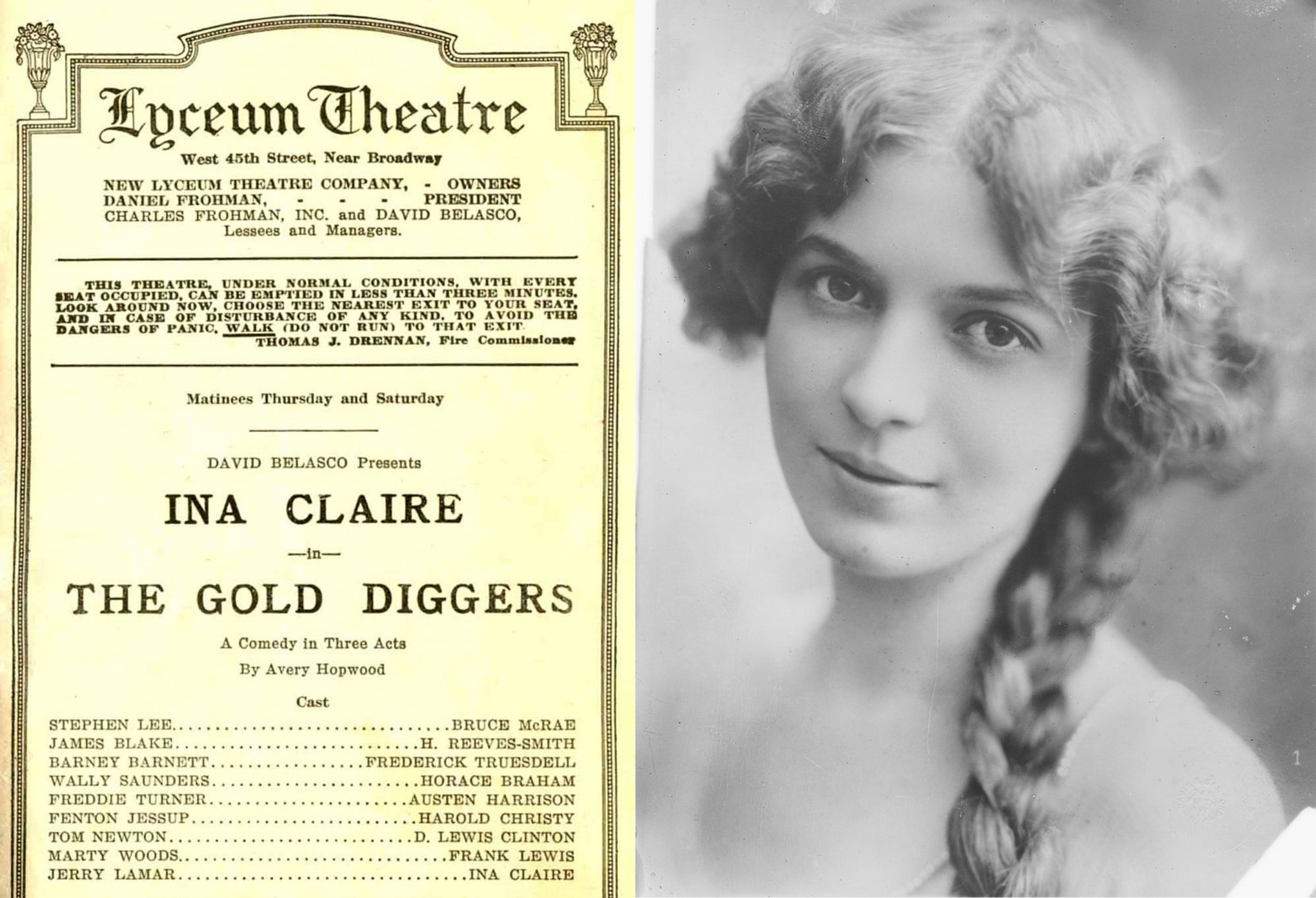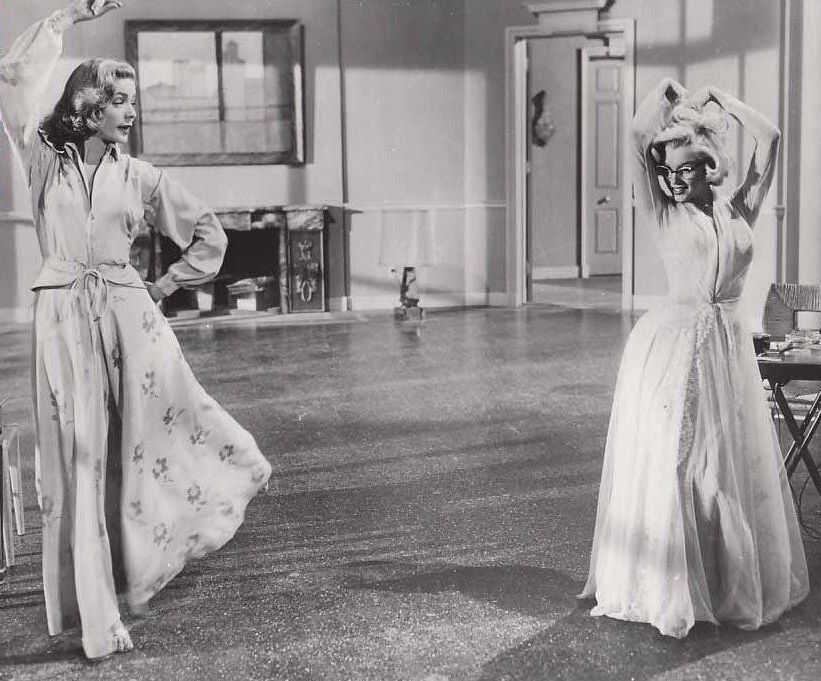In Avery Hopwood's play, "The Gold Diggers" (1919), a wealthy man, Stephen Lee, believes all chorus girls to be gold-diggers. He confides in Jerry Lamar, a chorus girl, and wants her to help him convince his nephew not to marry a chorus girl. Lamar disagrees with Lee and tries to prove him wrong. She fails because her other chorus girls, her friends, are shown to find romantic partners for financial gain. It was the first time that the term gold-digger was attributed to women. Earlier, coined by Rex Beach in his novel The Ne'er-Do-Well (1911), "gold-digger" referred to anyone who was money-mad, including men.

Fast-forward to 1936, Clare Boothe Luce, in her play "The Women", creates the gold-digger as the ultimate femme fatale—a conniving woman with an insatiable greed for money, someone who wrecks other people's marriages. Over time, the gold-digger became a recurring character type. The roles were often played by prominent actors like Marilyn Monroe (How to Marry a Millionaire, 1953) and, more recently, Priyanka Chopra (Aitraaz, 2004). The trope is deeply etched into public consciousness: beautiful women who seek financial stability rather than love in their relationships are greedy and dangerous.

The label persisted. Cis women romantically involved with or married to cis men of higher socioeconomic strata are now frequently called gold-diggers. Men in relationships with wealthier women don't get labelled; the gold-digger slur is reserved for women. For instance, no one seems to think Ben Affleck, whose net worth is $150 million, is a gold-digger even though he just married Jennifer Lopez, whose net worth is nearly four times his own at a whopping $ 400 million.
When uber rich women marry men with net worth bigger than theirs, they are not spared. Actor Salma Hayek (net worth approximately $200 million) and Sushmita Sen (net worth $10 million) have also been labelled gold-diggers. Hayek married billionaire businessman François-Henri Pinault, and Sen is supposedly dating millionaire businessman Lalit Modi. The assumption is that all women are greedy irrespective of their financial status; even rich women will "trap" richer partners to have access to luxuries they do not already have.

Moreover, heteronormative definitions of relationships have taught us that love is possible only between partners who fit the norms of conventional physical beauty. Seeing an "ordinary-looking" person with a conventionally attractive partner is unimaginable. If the supposedly ordinary-looking partner is a rich man, then the supposedly beautiful woman has not married for genuine love but his wealth. Bollywood women actors like Juhi Chawla and Shilpa Shetty, who married wealthy men that didn't look like Bollywood heroes, have been labelled gold-diggers. The Punjabi music industry, the second most popular music among Indian audiences, routinely portrays women as gold-diggers. Songs about materialistic women demanding men buy them expensive shoes, clothes, and cars are common even though, in India, affluent working women drive the luxury brand market.
Hip-hop, a major cultural influence in the US and consequently in the rest of the world, also promotes the gold-digger Black woman stereotype. Black feminist author Sesali Bowen points out that the image of Black women abandoning Black men to escape poverty is not based on facts as a majority of Black women choose to partner with Black men, and studies show Black men are twice as likely as Black women to marry partners of other ethnicities.
When two-time Grammy nominee rap artist Saweetie said women should reject men who don't buy them Birkins and pay bills, she got much flak. Everywhere, women asking men to share their wealth, demanding money for their labour, or aiming to escape generational poverty by accruing wealth are stigmatised. Men doing the same go unnoticed.
Men have received dowries for a long time, but that's never been a reason to call them greedy. Instead, dowries are incorporated into the institution of marriage as a worthwhile price to pay to "have" them or to get a daughter married. Even though dowry was criminalised in India in 1961, men continue receiving large financial "wedding gifts."
Historically, women's economic prospects have been drastically limited since capitalism started taking hold in the 16th century. Men assumed the role of providers not because women were lazy or incompetent but because only men could earn, inherit, trade, and own wealth. Women were confined to household duties, childbearing, and care work. Those in wealthy families were required to focus on looking presentable, shaping themselves as well-bred, and indulging in hobbies.
The world over, women have only recently gained access to the right to property—in the eighteenth century in France and Russia and the nineteenth century in the US and the UK. In India, landmark laws such as the Hindu Succession Act, the Indian Succession Act, and the Muslim Personal Law were introduced in the twentieth century to protect women's property rights through ancestral and marital acquisition. Before that, young women had legal access to wealth through their husbands, father, or male relatives. An adult woman's ascent to economic privilege depended entirely on the man she would marry. That was her sole access to housing, healthcare, and social standing.
Even today, family commitments negatively impact women's professional journeys while men benefit from having a family. A report found that 1 in 3 working women in Asia-Pacific feel inequalities at the workplace and home are holding them back. It is no surprise that men find it easier to take on the role of providers, whereas women still struggle with work for wages.
Men's rights activists often complain about being forced to make more significant financial contributions in the relationship or paying ludicrous amounts to women in alimony. Others feel forced to buy expensive gifts or find high-salary jobs to succeed in their romantic endeavours. These men believe they are victims of vicious gold-diggers—educated women who can earn money but nevertheless use men for financial gain. Members of a men's rights NGO called "Save Indian Family Foundation" have been lobbying against Sec 498-A, which aims to protect women from domestic abuse. They believe its sole aim is to give women a legal weapon to extort their husbands on false charges.
While more women have access to education and economic opportunities than in the past, the transformation hasn't been as dramatic as men's rights activists imagine. Systemic oppression still restricts most women from having the kind of access men have to capital and resources, creating a gendered wealth gap and maintaining dependence. The truth is that a majority of the world's women are poor. The increase in the number of girls enrolling for education doesn't change the fact that India still has one of the lowest labour force participation rates for women—19 per cent compared to 70 per cent for men.

Reddit and Quora communities ask questions such as "How do you avoid gold-diggers as a man?" or "What's the best way to identify a gold-digger?" Wealthy men who have sought financial gain are wary of women who haven't amassed their own wealth. There is no awareness or acknowledgement of how the patriarchal system makes it easier for men to convert their supposed merit into wealth while creating barriers for women.
Women face multiple barriers when they try to work for wages. Globally, women earn 20 per cent less than men, and it could take at least 151 years to put women and men on a level economic playing field. A study shows how women who enter fields dominated mainly by men (which would technically be all fields where work is highly paid) find that their pay gradually decreases.
On the surface, it may look like women aren't "putting their education to use" to earn at par with men. However, numbers show a grim picture. In 2021, 85 per cent of women working for wages in India were denied a raise, promotion, or work offer. A time-use survey conducted by National Statistical Office indicated that only 26 per cent of Indian men participate in unpaid domestic care work.

Globally, the time invested by women in unpaid care work is worth $10 trillion—unpaid labour on which deeply patriarchal and capitalist structures stand tall. In other words, women are working even more than men; only their work is either not rewarded or not considered 'real' work—physical, emotional, sexual, and care labour—all of which benefit and support men as they create and own wealth and resources.
On an average day, an urban working woman is preoccupied with taking the safest route to work, planning the travel, and doing a large chunk of household chores before getting started with work for wages. For some, such as construction labourers, it involves taking their children to work. Systemic barriers intensify for women in rural, lower-caste, and lower-economic strata. Only 58 per cent of rural women in India are literate. Most women face the double whammy of gender and other systemic barriers, further limiting their access to economic opportunities. The World Bank has found that 88 per cent of all countries restrict women's economic prospects in some way or another.
The bare minimum women have achieved in terms of freedom is weaponised against them to limit their access to social and economic mobility to just enough required to sustain and supplement men’s ambitions. In a world where most wealth is still in men's hands, women’s legitimate ambitions for financial gain are perceived as a threat no matter which method they choose to succeed. The gold-digger label is an aggressively misogynistic admonishment to women who try to gain upward mobility through their partners.










